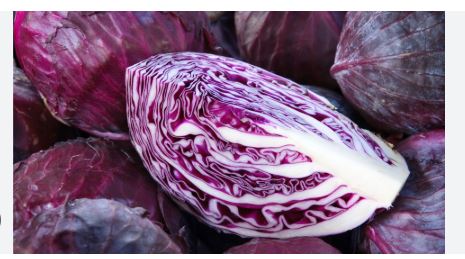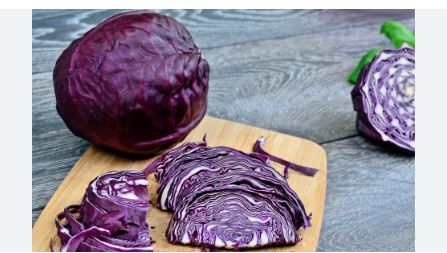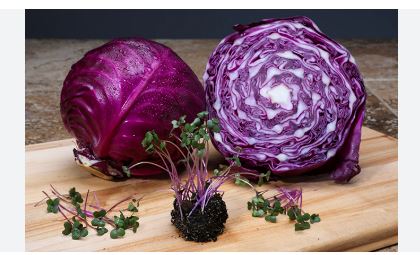
Botanical Classification
Red cabbage, scientifically classified as Brassica oleracea var. capitata f. rubra, is a member of the Brassicaceae family, which includes cruciferous vegetables such as broccoli, kale, and Brussels sprouts.
This cultivar is a type of head cabbage, distinguished by its vibrant purple or reddish leaves. Like other Brassica oleracea varieties, it descends from wild cabbage native to coastal Europe, sharing its species with green cabbage, savoy cabbage, and other related crops, but its unique coloration sets it apart.
Origin and History
Red cabbage likely originated in Europe, with cultivation records dating back to the 12th century in Germany and surrounding regions. It was selectively bred for its striking purple-red leaves, which result from high levels of anthocyanins, and its ability to thrive in cooler climates.
By the Middle Ages, it was a staple in European diets, valued for its long storage life and vibrant color, which added visual appeal to dishes. Today, red cabbage is grown worldwide, particularly in Europe, North America, and Asia, and is a key ingredient in traditional dishes like German sauerkraut and Eastern European borscht.
Identifying Characteristics

Red cabbage is easily recognized by its compact, round heads and vivid purple or reddish leaves, which are smooth, waxy, and tightly packed. The heads typically weigh 2–5 pounds and have a dense, crisp texture.
The outer leaves are darker and tougher, while inner leaves are lighter and more tender. The vibrant color, caused by anthocyanins, can vary in intensity depending on soil pH and growing conditions, with more acidic soils producing redder hues and alkaline soils yielding bluer tones.
Taste
Red cabbage has a robust, slightly peppery flavor with a subtle sweetness, stronger than green or pointed cabbage but balanced by its crisp texture. When raw, it offers a crunchy bite with a mild bitterness, which softens when cooked, developing a smoother, sweeter profile.
Its bold flavor pairs well with tangy or rich ingredients, and cooking methods like braising or pickling enhance its natural sweetness, making it a versatile ingredient in both raw and cooked dishes.
Seasons/Availability
Red cabbage is a cool-season crop, typically available year-round due to its excellent storage qualities and cultivation in diverse climates. Its peak season in the Northern Hemisphere is late summer to early winter (August–December), with optimal flavor in fall when cooler temperatures enhance sweetness.
It tolerates light frost, which can intensify its color and flavor, and is widely available in supermarkets, farmers’ markets, and specialty grocers during these months, with stored cabbages extending availability into spring.
Culinary Uses
Red cabbage is prized for its vibrant color and versatility in culinary applications. Raw, it adds crunch and color to salads, slaws, and garnishes, often paired with apples, vinegar, or citrus to balance its flavor. Cooked, it shines in braises, stir-fries, and stews, where its texture softens and sweetness deepens.
It’s a staple in fermented dishes like sauerkraut and kimchi, and features prominently in European cuisines, such as German red cabbage with apples or Polish bigos. Its striking hue also makes it a popular choice for visually appealing dishes.
Nutritional Value

Red cabbage is a nutrient-dense, low-calorie vegetable, providing about 30 calories per cup. It is rich in vitamin C, an antioxidant that supports immune health, and vitamin K, essential for blood clotting and bone health. It also offers dietary fiber for digestion, folate, manganese, and small amounts of vitamin B6 and potassium.
The anthocyanins responsible for its color provide additional antioxidant benefits, potentially reducing inflammation and protecting against certain cancers. As a cruciferous vegetable, it contains glucosinolates, compounds linked to cancer-fighting properties, making it a valuable dietary addition.
Cultivation of Red Cabbage
- Climate Requirements: Red cabbage thrives in cool, temperate climates with temperatures between 45°F and 75°F (7°C–24°C). It tolerates light frost, which enhances sweetness and intensifies its purple-red color by boosting anthocyanin production. Temperatures above 80°F (27°C) can cause bolting or loose heads, making it best suited for spring or fall planting in most U.S. regions, targeting late summer to early winter harvests.
- Soil Preferences: This cabbage grows best in fertile, well-drained loamy soil with a pH of 6.0–7.5. Incorporate organic matter like compost or aged manure to enhance soil fertility and structure. Good drainage prevents root rot, and a slightly acidic to neutral pH optimizes nutrient uptake and influences color, with more acidic soils producing redder hues and alkaline soils yielding bluer tones.
- Planting Time: In the U.S., sow red cabbage seeds in early spring (February–March) for a late spring to early summer harvest, or in late summer (July–August) for a fall to early winter harvest. Start seeds indoors 6–8 weeks before the last frost or sow directly when soil temperatures are 50°F–70°F (10°C–21°C). Transplants should be set out when seedlings are 4–6 inches tall.
- Seed Selection: Choose high-quality seeds of red cabbage varieties like ‘Red Acre’, ‘Ruby Perfection’, or ‘Kalibos’ for disease resistance, vibrant color, and uniform heads. Select varieties suited to your region’s climate and season length. Fresh seeds from reputable suppliers ensure high germination rates, as older seeds may lose viability, impacting crop success.
- Spacing and Planting: Space plants 15–18 inches apart in rows 24–36 inches apart to allow for compact, round heads to form. Plant seedlings at the same depth as their nursery pots, firming soil around roots to ensure stability. Proper spacing promotes air circulation, reducing disease risk, and provides adequate sunlight for vibrant leaf color and head development.
- Watering Needs: Maintain consistent soil moisture, providing 1–1.5 inches of water per week, adjusted for rainfall. Even watering prevents head splitting or cracking, especially during head formation. Avoid waterlogging, which can lead to root issues, and use drip irrigation or soaker hoses to deliver water to roots while keeping foliage dry to minimize fungal diseases.
- Fertilization: Red cabbage is a heavy feeder, requiring a balanced fertilizer (e.g., 10-10-10) at planting to support vigorous growth. Side-dress with nitrogen-rich fertilizer, such as blood meal or fish emulsion, 3–6 weeks after transplanting and again when heads begin forming. Avoid excessive nitrogen late in the season to prevent leafy growth over head development.
- Pest Management: Monitor for pests like cabbage worms, aphids, and cabbage root maggots. Use floating row covers to protect young plants from egg-laying insects, hand-pick caterpillars, or apply organic controls like neem oil or Bt (Bacillus thuringiensis). Companion planting with herbs like thyme or introducing beneficial insects like ladybugs can help manage aphid populations naturally.
- Disease Control: Red cabbage is susceptible to fungal diseases such as clubroot, black rot, and downy mildew, particularly in wet conditions. Practice crop rotation every 3–4 years, maintain soil pH above 6.0, and ensure good drainage to reduce disease risk. Remove infected plant debris and select disease-resistant varieties to minimize issues, using fungicides only as a last resort.
- Weed Control: Keep the growing area weed-free to reduce competition for nutrients, water, and light. Regular hand-weeding or hoeing is effective, especially early in the season. Apply organic mulch, such as straw or wood chips, to suppress weeds, retain moisture, and regulate soil temperature, supporting healthy root systems and vibrant leaf color.
- Support and Pruning: Red cabbage forms dense heads and typically doesn’t require staking, but hilling soil around the base can stabilize plants in windy areas. Remove yellowing or damaged outer leaves to improve air circulation and reduce pest and disease risks. Minimal pruning is needed, but trimming lower leaves can enhance head appearance and focus energy on head formation.
- Harvesting: Harvest red cabbage when heads are firm and reach 2–5 pounds, typically 70–100 days after transplanting, depending on the variety. Cut heads at the base with a sharp knife, leaving a few outer leaves for protection or potential regrowth in mild climates. Harvesting after a light frost can enhance sweetness and color intensity, but avoid delays to prevent splitting.
- Post-Harvest Care: Store red cabbage in a cool, humid environment (32°F–40°F, 0°C–4°C) with 90–95% humidity for up to 3–6 months. Wrap heads in plastic or store in perforated bags to maintain freshness and prevent wilting. For continuous harvests, stagger plantings every 2–3 weeks during the planting season to ensure a steady supply of vibrant heads.